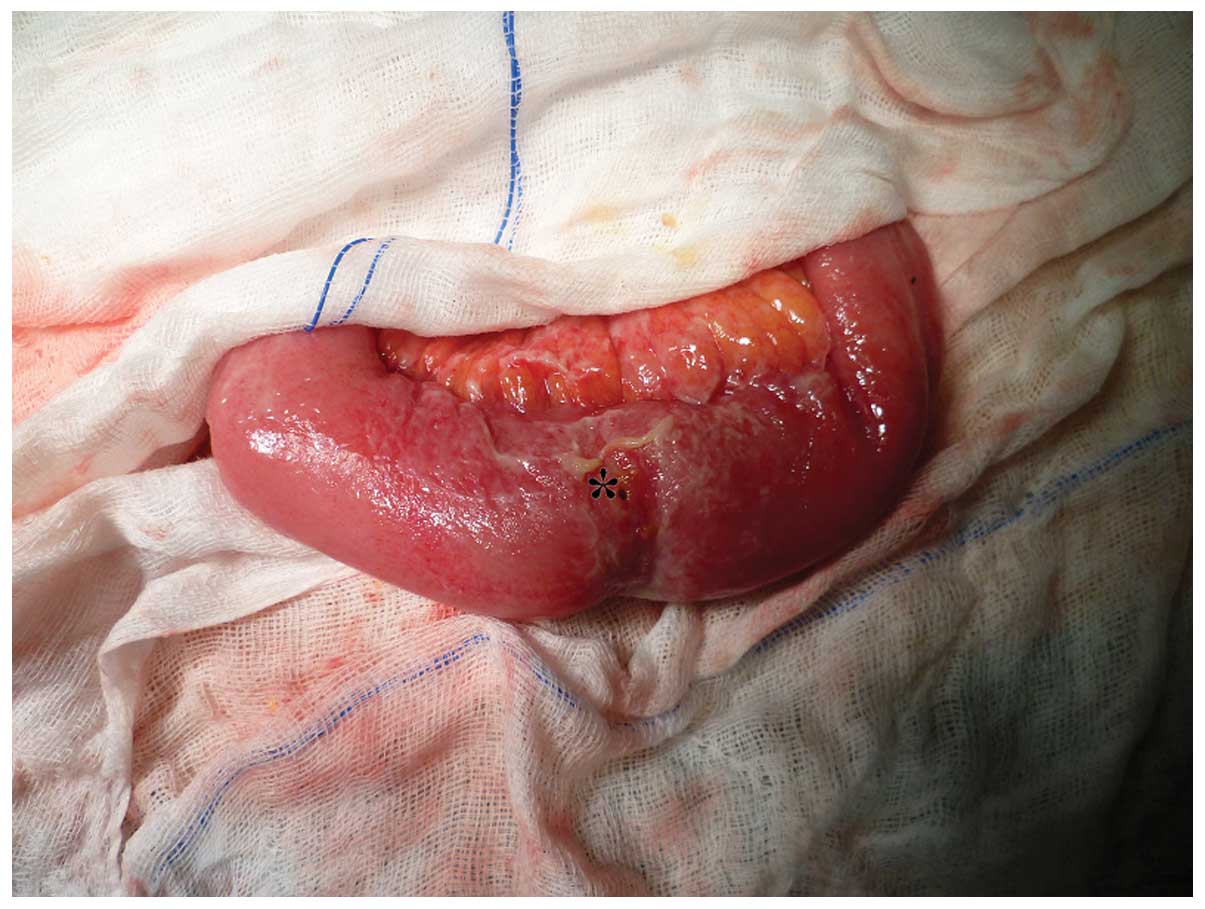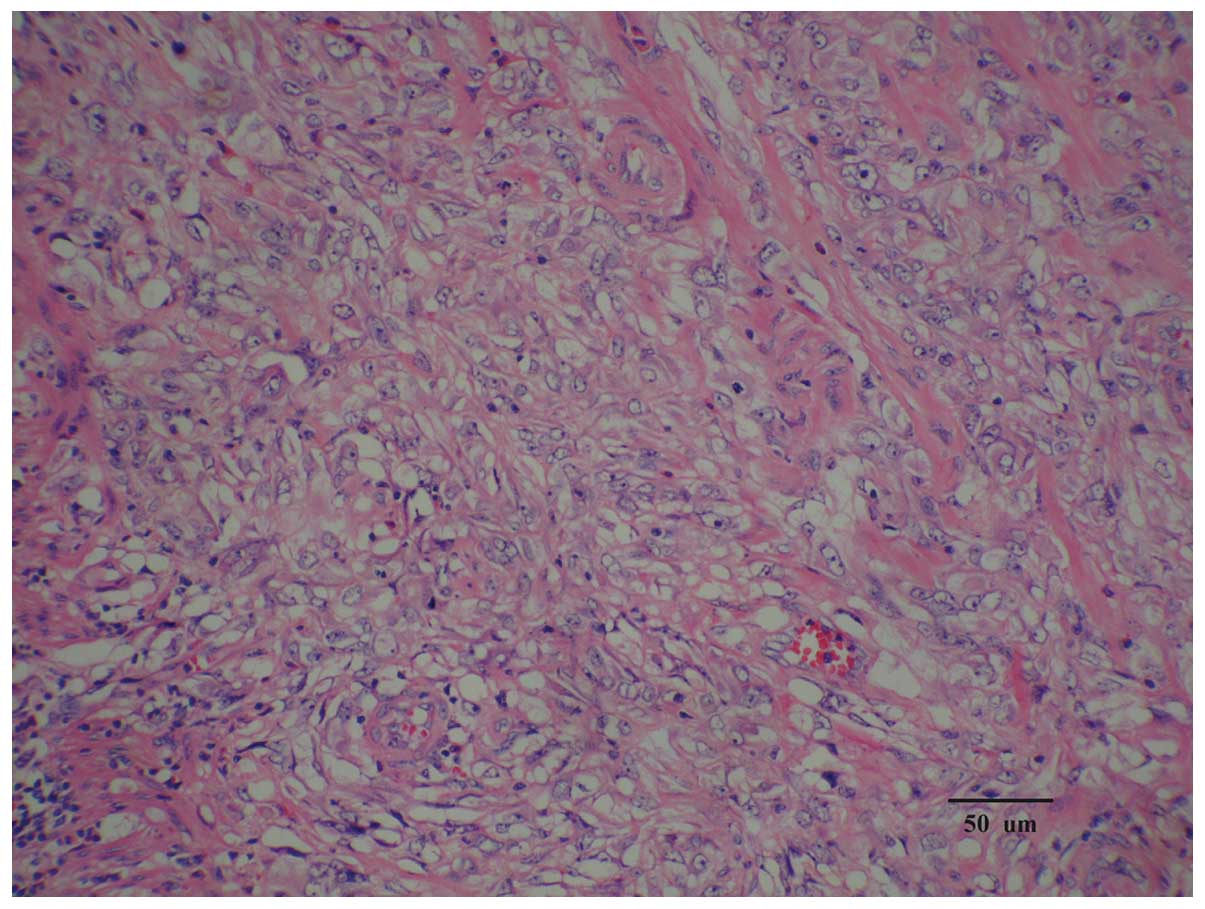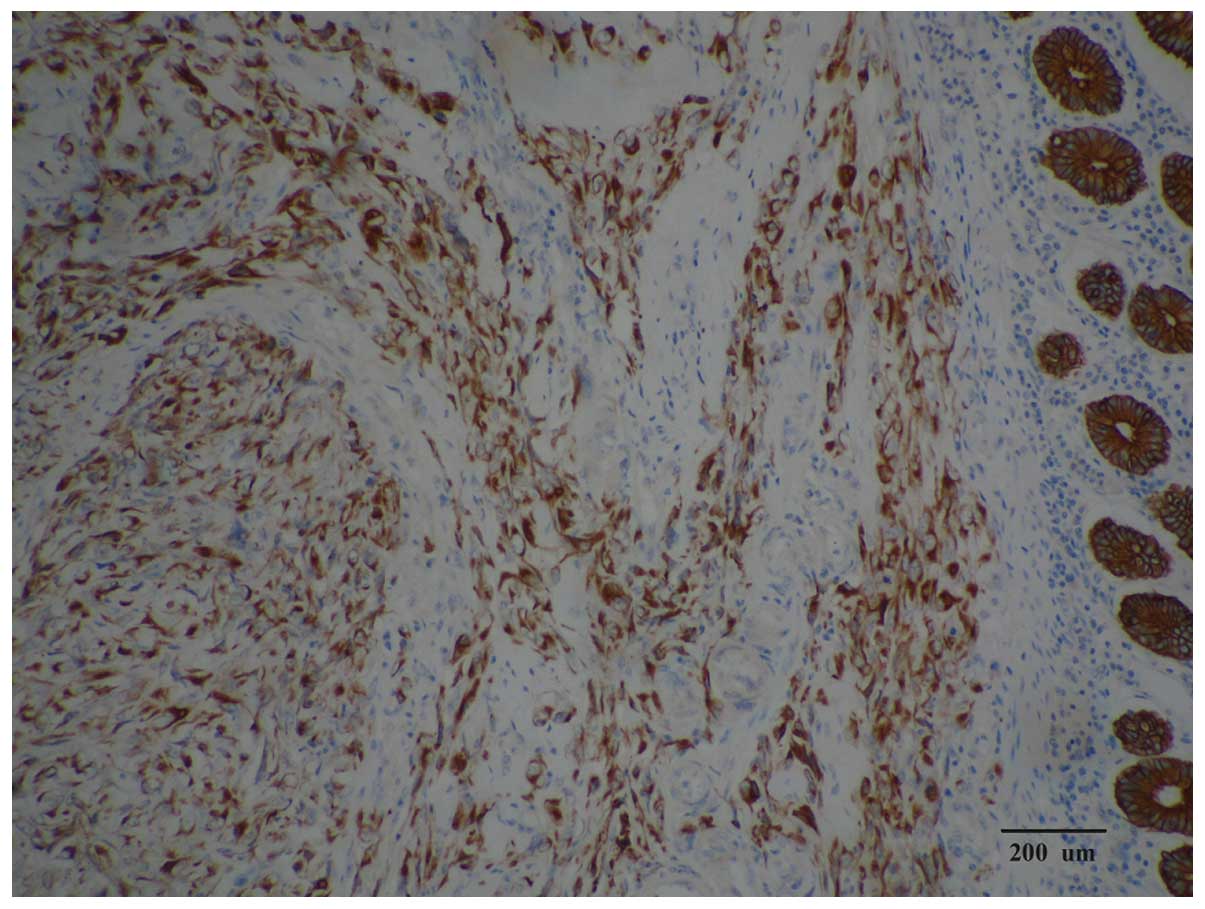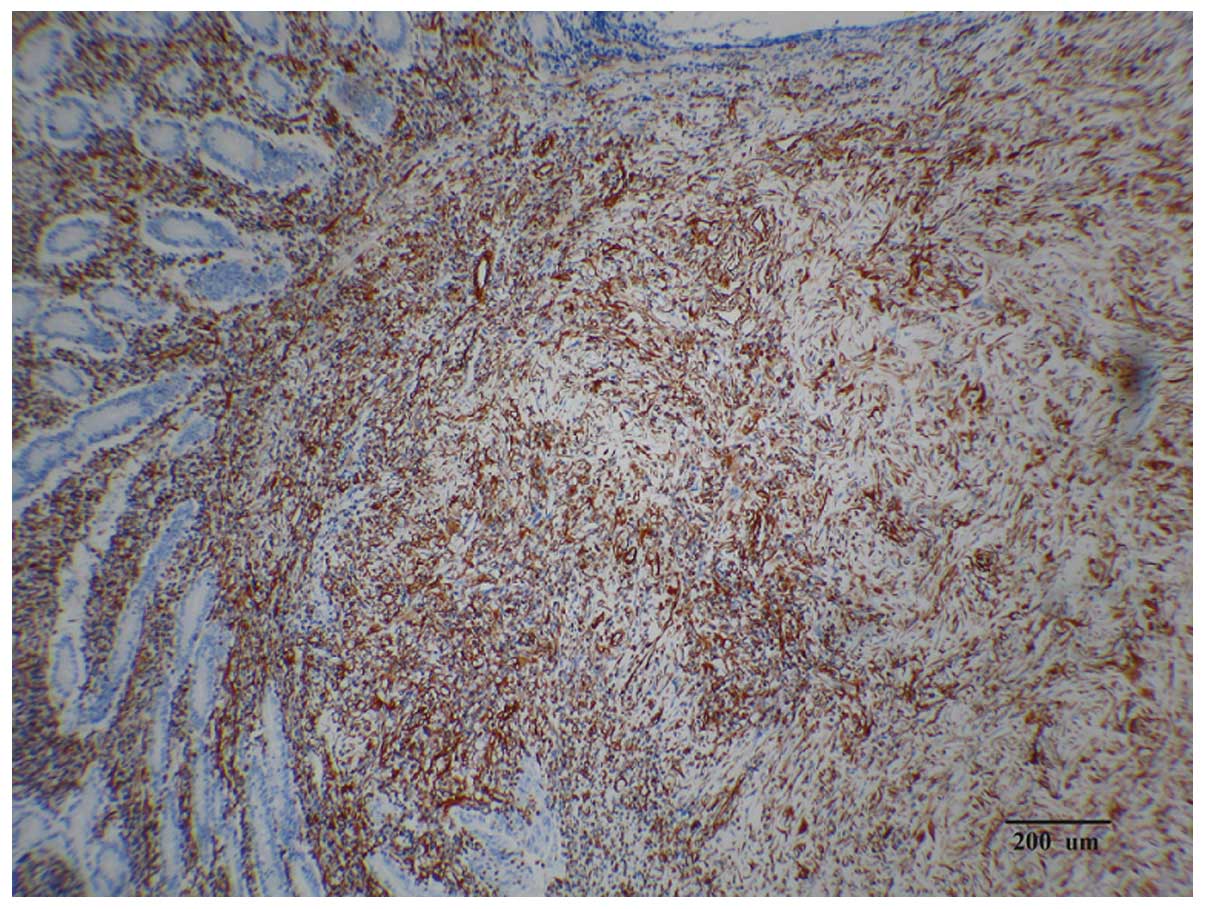Introduction
Sarcomatoid carcinoma is a rare tumor comprised of
malignant cells that possess properties of epithelial and
mesenchymal carcinomas (1). In
addition, sarcomatoid carcinoma has been described in various organ
systems, including salivary, thyroid, breast and skin tissues, as
well as the respiratory and digestive systems (1,2).
Sarcomatoid carcinomas of the small intestine are rare with only a
few dozen cases reported in the literature (1,3). In
this case report, we present the occurrence of a sarcomatoid
carcinoma in the jejunum of a 70-year-old Chinese female.
Histological and immunohistochemical staining are crucial in the
diagnosis of small intestinal sarcomatoid carcinoma, due to
nonspecific clinical observations. To date, surgery remains the
optimal therapeutic approach and previous studies have demonstrated
that chemical or radial treatment do not improve the overall
survival rate (1,2,4,5).
Case report
Clinical presentation
A 70-year-old female was hospitalized due to sudden,
persistent and generalized abdominal pain that had continued for
>5 h. The patient did not report nausea or vomiting. The
patient’s vital signs were stable upon admission and conservative
treatment, including ceftriaxone and omeprazole, did not relieve
the pain. Abdominal examination revealed generalized and rebound
tenderness. Digital rectal examination revealed no mass or
bleeding. Evaluation of blood samples indicated an elevated white
blood cell count (7.36×109 cells/l) with a high
percentage of neutrophils (76.9%). Abdominal X-ray revealed the
possible presence of a gas shadow under the diaphragm and the
computed tomography scan observations were normal. Patient consent
was obtained prior to surgery.
Surgical procedures
Immediately following the diagnosis of acute
peritonitis, an exploratory laparotomy was performed that revealed
a section of narrowing with an accompanying perforation (0.1×0.1
cm) in the jejunum, ∼60 cm from the Treitz ligament (Fig. 1). During the laparotomy, ∼500 ml
liquor puris was present in the abdominal cavity. The
surgeon removed a section of the jejunum (6-cm long) and performed
a side-to-side small bowel anastomosis. No evidence of metastasis
to the liver, spleen or stomach was observed.
Pathological analysis
Pathological studies demonstrated that the tumor was
characterized by spindle-shaped cells with nuclei that were
heteromorphic and exhibited multiformity. In addition, karyokinesis
was observed (Fig. 2). Following
deparaffinization and rehydration, the sections were treated with
3% hydrogen peroxide to block endogenous peroxidase activity. Heat
epitope retrieval was performed by microwave boiling the sections
in 10 mmol/l citrate buffer (pH 6.0) for 12 min. Primary antibody
was performed to identify vimentin, cytokeratin 8 (CK8), pan-CK,
S-100, cluster of differentiation 68 (CD68), Ki67, CD34, CD117,
desmin (Des), epithelial membrane antigen (EMA), leukocyte common
antigen (LCA) and CD30. Samples were incubated overnight at 4°C.
Immunostaining was performed with an EnVision™ system (Dako,
Hamburg, Germany) on an Auto-Stainer (Dako). The antigen-antibody
immunoreaction was visualized using diaminobenzedine (Dako) as a
chromogen, and the slides were counterstained with Mayer’s
hematoxylin. For each specimen, a negative control was obtained by
omitting the primary antibody. Immunohistochemical staining
revealed the following: vimentin (+++), CK8(++), pan-CK (+), S-100
(+), CD68 (+), Ki67 (5% +), CD34 (-), CD117 (-), Des(-), EMA(-),
LCA (-) and CD30 (-). The diagnosis was confirmed as sarcomatoid
carcinoma of the jejunum based on histological and cytological
observations.
Discussion
Sarcomatoid carcinoma is an extremely rare biphasic
tumor characterized by a combination of malignant epithelial and
mesenchymal cells (2). Although
rare sarcomatoid carcinomas have been diagnosed in the small
intestine, these tumors of the small bowel are normally diagnosed
in middle-aged to older patients (mean age, 57 years), with a male
to female ratio of 1.5:1 (2).
Patients diagnosed with sarcomatoid carcinomas have a poor
prognosis due to the high level of invasiveness of the tumor. Of
these patients, ∼70% succumb to sarcomatoid carcinoma within 2
months to 3 years following the initial diagnosis (1).
Sarcomatoid carcinoma of the small bowel may be
polypoid or endophytic with central ulceration. These tumors
usually cause intestinal bleeding or obstruction (1,2).
Reid-Nicholson et al previously reported a case of small
bowel sarcomatoid carcinoma with perforation, in which the
patient’s main complaint was melena (1). Therefore, the present case report is
the first to describe sarcomatoid carcinoma in a Chinese patient
that presented with acute peritonitis as the first clinical
manifestation.
In this case, the diagnosis was based on
pathological observations. Typically, the diagnosis is based on the
observation that the sarcomatoid component is composed of
epithelium-like cancer cells in a transitional zone between the
sarcomatoid and carcinomatoid components. However, in this case,
only poorly differentiated spindle cells were observed in the
tumor. Since sarcomatoid carcinomas have only minor histological
differences compared with other intestinal spindle cell tumors, the
diagnosis was difficult to confirm by hematoxylin and eosin
staining alone. Therefore, immunohistochemical analysis was
necessary.
Immunohistochemical staining also contributes to the
diagnosis, along with routine histological examinations. In the
majority of sarcomatoid carcinomas, epithelial- and
mesenchymal-like components exhibit positivity for EMA. In
addition, ∼90% of intestinal sarcomatoid carcinomas are positive
for vimentin. Certain cases may also exhibit focal positivity for
neuroendocrine and neuron-specific markers (1,2). The
present case exhibited positivity for vimentin (Fig. 3), pan-CK (Fig. 4) and S100 (neuroendocrine marker),
consistent with previous studies (1–3).
Although the current case was negative for EMA, the diagnosis was
determined based on the aforementioned observations and with the
consideration of the variability of intestinal sarcomatoid
carcinomas. Other intestinal spindle cell tumors typically express
positivity for CD34 and CD117, as well as tumor-specific markers
(2). For example, leiomyosarcoma
presents with positivity for muscle-specific actin and Des
(1), while these markers are
negative in intestinal sarcomatoid carcinomas. Therefore, analysis
of immunohistochemical staining clearly plays a decisive role in
the process of differential diagnosis for sarcomatoid
carcinoma.
Currently, radical excision remains the best therapy
for intestinal sarcomatoid carcinomas (2,4).
Previous studies have indicated that a wide excision area of the
intestine around the tumor may increase the patient survival rate
(2,4). In the present case, the patient
exhibited serious contamination of the abdominal cavity and
generalized tissue swelling prior to the surgical procedure.
Therefore, only the section of the jejunum with the perforation was
removed due to the poor condition of the patient. Adjuvant therapy
has not been reported to improve therapeutic outcomes (1,2,4,5).
In the present case, the patient refused further adjuvant therapy
due to the current therapeutic progress. At the last follow-up at 7
months, the patient was living without any signs of metastasis as a
result of the disease.
Ki67 is widely used to study the biological and
proliferative status of various tumors. In general, higher
positivity rates for Ki67 are associated with poor prognosis
(6). The patient in the present
case report exhibited a low positivity rate for Ki67, which may
have influenced the individual’s continued favorable prognosis.
In conclusion, the possibility of perforated small
bowel malignant tumor should be taken into consideration in the
presence of acute abdominal pain. Furthermore, Ki67 is a potential
prognosis marker for the individualized treatment of small
malignant bowel tumors.
Acknowledgements
This work was supported by the
foundation of Pudong District (PW2011B-2 and PWRq2012-13).
References
|
1.
|
Reid-Nicholson M, Idrees M, Perino G and
Hytiroglou P: Sarcomatoid carcinoma of the small intestine: A case
report and review of the literature. Arch Pathol Lab Med.
128:918–921. 2004.PubMed/NCBI
|
|
2.
|
Ozturk E, Yilmazlar T and Yerci O: A rare
tumor located in the anorectal junction: Sarcomatoid carcinoma.
Turk J Gastroenterol. 17:236–239. 2006.PubMed/NCBI
|
|
3.
|
Yucel AF, Kocakusak A, Arikan S, Demirbag
N, Tarlaci A and Batur S: A rare cause of acute abdomen: Perforated
primary sarcomatoid carcinoma of the small intestine - report of a
case, with a brief review of the literature. J Cancer Res Ther.
7:348–350. 2011. View Article : Google Scholar
|
|
4.
|
Conzo G, Giordano A, Candela G, Insabato L
and Santini L: Colonic carcinosarcoma. J Gastroenterol Hepatol.
18:748–749. 2003. View Article : Google Scholar : PubMed/NCBI
|
|
5.
|
Ishida H, Ohsawa T, Nakada H, Hashimoto D,
Ohkubo T, Adachi A and Itoyama S: Carcinosarcoma of the
rectosigmoid colon: Report of a case. Surg Today. 33:545–549.
2003.PubMed/NCBI
|
|
6.
|
Ma YL, Peng JY, Zhang P, Liu WJ, Huang L
and Qin HL: Immunohistochemical analysis revealed cd34 and ki67
protein expression as significant prognostic factors in colorectal
cancer. Med Oncol. 27:304–309. 2010. View Article : Google Scholar : PubMed/NCBI
|


















